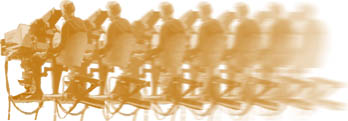
| The studio lights were not on pantographs
as they are today and with direction and intensity controls. No, the lights were
hoisted into position by rope and pulley and set in position over night, direction
of light was controlled by adjusting the lights’ swivels before they were hoisted
and brailed off from the lighting galleries. Big dimmers in the corner of studios
controlled intensity. The studio electricians were standing by all the time
to make physical lamp adjustments. The studios were very hot to work in
because of the intensity of light the cameras needed. Still the tech. ops.
Crews had to wear jackets and collar and ties. Now the boys did not think
that was strange because everybody had done or just done National Service
and were used to strict dress codes. Everything was live. Big plays had two-day rehearsals starting at 1400 (and until 2200) and transmitting at 2000 say on the second evening. Supper at 1900, line up at 2000, Tx at 2030. Live. Later on in the fifties film telerecordings were made during the live transmission on sep. mag 16 mm. A film editor was present in the gallery to retake mistakes after transmission. But of course the viewers saw all the mistakes, if any. Real time rehearsals were a favourite of Kevin Sheldon, a children’s drama producer. He had very bad eyesight, by the way, and wore bottle bottom specs. I don’t think he could see the monitors in the gallery properly at all. He produced and directed “Stranger on the Shore”, “A Tale Two Cities”, “Rob Roy” and a host of other serials in half hour episodes at Lime Grove. We started rehearsal at 1000 and transmitted live at say 1730. Anyway the real time idea was instead of crawling through and lining up every shot, you dashed through in real time, not stopping for any camera or sound problems or artiste problems either. The idea was that in half an hour one knew what the bogeys were instead of them becoming apparent a couple of hours into rehearsal. Very, very exhilarating. Explosions and destruction effects were of course all physical and happened in the studio. Live. Once I was on Camera 4 in studio D. The camera and I were physically on a rostrum inside the battlements of the Bastille. Come the live transmission the storming pyrotechnics were used for the first time with plenty of dry ice - I could not see a thing. In the sequel to “A for Andromeda”, done in Riverside, a scene man was badly injured when Doric column type scenery was pulled down as an effect. To open the iris If you were on camera in studios D and G in the mid fifties one had to work the iris control which was actually in the camera turret as rehearsed with racks (Vision Control) when you lined up your shot on the run through or transmission. The camera cables in those days were very heavy and they made a hissing sound as the camera mountings moved across the studio floor. Junior members of the crews had to lift them right off the floor on camera moves to keep down the sound – cable humping. |
 |